Table of content
Bonds are one of the most popular investment vehicles in the financial markets. The essential principle behind this investment is quite simple. The governments and corporations issue bonds, choosing the nominal value for each of the issued security. Then they sell it at the auctions.
The new owners of those bonds in return to lending money to governments or corporations receive either a discount or a coupon, depending on the duration of the security. Each bond has its own term, ranging from 1 week to going as far as even 30 years. Once the term of this security expires, the owner will get the invested principal back in full. At the same time, owners can sell their bonds at the secondary market, before the term expires.
So as we can see here, unlike with stocks, the principal of the invested amount is secure. Consequently, if an investor holds bonds until its maturity date, he or she does not have to worry about the daily market fluctuations, because at the end of the term the market participant will get back the invested amount. This makes the bond market very attractive for many risk-averse investors.
Here it is also worth noting that there is a significant influence of the bond market in Forex currency pairs. The fact of the matter is that many bond transactions involve millions of dollars worth of Foreign exchange transactions. Therefore, the interest rates on bonds, also called bond yields, can have a major impact on the Forex market movements.
The general principle here is that the bonds with higher real interest rates tend to benefit currencies in which they are denominated. This is because bond investors are always looking to preserve the purchasing power of their capital.
However, it is important to mention that this is not always the case. If the bond yields of one particular country rise sharply because investors lose confidence, then this can be potentially very damaging for its currency.
Bond Market vs Forex Market
Before moving on to describing the aspects of the bond market effect on Forex, let us describe the differences between those two markets. After all, each trading and investment vehicle does have its own advantages and disadvantages.
When discussing the differences between bonds and Forex, the first thing which obviously comes to mind is the fact that in the case of the latter the invested funds are not secure. Obviously, the market participant is free to choose the amount invested in the currency trading, however, there is clearly no guarantee that the trader will always get his or her money back. Therefore, the balance of the trading account is constantly subject to day to day market fluctuations.
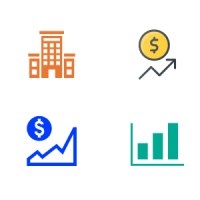
On the other hand, the invested capital in the bond market is secure. This is because at the end of the term, the government or the corporation, which issues this security, will return their invested money in full. There are of course daily market price fluctuations of bond prices as well. However, regardless of those market movements, the investors know that if they hold their bonds until maturity, they will get their money back. So this is one of the most attractive features of bonds, especially for those investors with relatively low risk tolerance.
The second important difference between those securities is the fact that relatively speaking the Forex market offers investors higher potential returns. For example, over the last 25 years, the yields of 10 year US treasury bonds have fluctuated between 0.5% to 7%. Nowadays, due to near-zero interest rate policies by all major central banks, the rate of potential returns is much closer to the lower end of this range.
On the other hand, some successful Forex traders earn from 1% to 5% monthly return. This means that their annualized returns, even if we exclude the compounding effects, will range between 12% to 60%.
The third very important difference is that despite its potential lucrative rate of returns in the Forex market, it is far from guaranteed. In fact, the amount of earnings in this market is highly dependent on the skill and experience of the trader. Some successful traders might earn double digit returns for years. On the other hand, some of them lose money consistently and there are of course plenty of market participants who are in the middle of those two extremes.
In contrast to this, the bond market does not demand so much skill and experience from investors. They do not have to necessarily actively trade bond securities to earn some money. They always have a safer and more convenient option of buying and holding bonds and receiving income on a regular basis.
Income Investing in Bond and Forex Markets
Here it is worth mentioning that there is a difference in how income investing works with both of those markets. Forex traders can earn regular income through carry trades. This involves borrowing in a low-yielding currency in order to buy higher-yielding currency.
As a result, the market participants receive daily interest payments from the brokerage company. The only downside to this is that the amount of interest depends on the changes in the central bank interest rates and the commission rate structure of the given broker.
So obviously those variables can fluctuate significantly over the months. As a result, some carry trades which paid a decent amount of returns in the past might no longer be profitable for investors. At the same time, some trades, which offered very little return, now might become more lucrative options due to interest rate changes or other reasons. Therefore, with carry trades, the rate of return is not fixed and varies considerably over time.
On the other hand, once the investor purchases bonds, the rate of nominal or real return is fixed. The exact method and amount of returns investors receive depends on the type of security
Firstly, there are conventional short term treasury securities. In the US, those treasuries, which have the maturity of 1 year or less are sold at a discount. So here instead of receiving regular interest payments, the investor purchases the security at a discount, and at the end of the term, receives the full nominal value of the security.
For example, an individual might buy an individual treasury with 1-year maturity worth of $103, at a discounted price of $100. If the investor holds on to this security until the end of the turn, he or she will receive $103, earning the 3% nominal return in the process.
The longer term treasury bonds pay interest twice per year, with 6-month intervals, until the maturity date. Those payments are also called coupon payments. The coupon rate is determined by the issuing government or corporation and remains fixed for the duration of the security. The bond is sold at the auction, where its price is determined by the market. Those investors who have not participated in those auctions still buy bonds at the secondary market.
So if an individual purchases a 10-year bond, worth $3,000 at a 4% coupon rate, then the investor will receive $60 coupon payments every six months. After 10 years, the investor will get back the initial $3,000 investment amount.
Finally, we have the so-called index-linked bonds. In the United States, they are called the ‘treasury inflation protected securities’, also known as TIPS. As the name implies, those bonds are designed to protect investors from losing purchasing power to inflation. So how does this work in practice?
Well, in order to answer this question, let us return to our previous example. Let us suppose that the investor still intended to invest $3,000 in the bond market. However, instead of buying the 10-year standard bond, the individual decides to buy a 10-year index-linked bond with the coupon rate of 1%. Because of the fact that investors earn higher returns with TIPS when the inflation rises, the interest rate on those is typically lower than conventional bonds. Finally, let us further suppose that in this 10-year period, the consumer price index (CPI) has risen by 30%.
The investor will receive $15 coupon payments during those 10 years with 6-month intervals, as before. However, the actual amount of payments will increase alongside with inflation, reaching $19.5 by the end of the term. Once the bond matures, the investor will receive $3,900 which according to the CPI should have the same purchasing power as $3,000 did 10 years ago.
The index-linked bonds became more popular during the last two decades. The reason for this is the fact that with those securities investors do not have to worry about the fluctuating rates of inflation, knowing that those securities can help them to preserve the purchasing power of their capital.
How does Bond Market Affect Forex?
At this stage, many people might wonder how bonds affect the Forex market? Well, to respond to this question, it is important to note that the bond market does not operate in isolation of Foreign exchange markets. Obviously, there are always some domestic investors, who can just take their hard-earned money and buy the local bonds. However, there are plenty of international investors as well.
This means that higher yields tend to attract more investors to the bond markets. Since the foreign investors have to convert their capital into the local currency, this creates a natural demand for those assets. As a result, the currency with higher yields tends to appreciate against most of its peers.
To illustrate how does the bond markets affect currency exchange rates, let us take a look at this weekly EUR/USD chart:
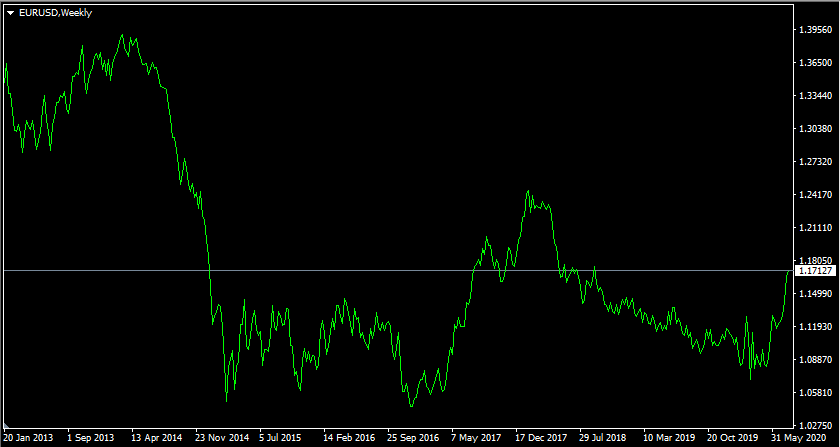
As we can see from the above diagram, by January 2013, the Euro traded at $1.35 level. According to Eurostat at that time the 10-year Euro area government benchmark bond yield stood close to 2.4%, later into the year, the yields reached 3.1%. At the same time, the US 10-year treasury bond yields were near 1.9%. This gave the European currency a significant advantage over the USD. As a result of this situation, the Euro has risen steadily, eventually reaching $1.39, by April 2014.
However, despite those developments, from this period the situation began to change considerably. During the subsequent years, the European bond yields fell steadily, going all the way down to 0.35% by June 2020. It goes without saying that this made the Eurozone bonds very unattractive investments for the majority of investors.
On the other hand, the yields on 10-year US treasury bonds have mostly stayed within 1.5% to 3% range. The predictable result of those dynamics was the appreciation of the US dollar. As we can see from the chart above, the EUR/USD pair has dropped all the way down to $1.05 level by March 2015. Despite this massive decline, the Euro did manage to stay above the parity level with the dollar and settled for a ranged trading.
This state of affairs persisted until May 2020. By that time the yields of 10-year US bonds have already dropped significantly, going all the way down to 0.6% by the end of July 2020. As a result, the US dollar has lost the advantage in yields it had before. Consequently, by that time the Euro has already risen to $1.17 level.
So as we can see from this example, changes in relative bond yields can have a significant influence on the Forex exchange rates. Consequently, the latest changes in the bond yields can give traders early clues about future possible movements of the currency pairs.
Nominal vs Real Yields
When discussing how the bond yields affect currencies, it is important to make a distinction between the nominal and real yields. The former measures the rate of return in actual dollars, while the latter also takes inflation into the account.
For the purpose of better understanding those two terms, let us take an example. Let us suppose that the investor buys a bond at its nominal value of $5,000, with a 3% annual coupon rate. At the same time, the inflation rate in the country is 2%.
So as a result of this transaction, the individual will earn $150 per year from coupon payments, which represents 3% of the invested amount. Therefore, the annual nominal yield of the currency stands at 3%.
However, if we want to calculate the real yield, we need to subtract the rate of inflation from the overall rate of return. So in this case, the real interest rate on this bond will be 3%.
The most important point here is the fact that in general, the real interest rates are more important to investors then nominal rates. This is because one of the most essential aims of investing is to preserve the purchasing power of one’s savings. So for example, the 8% annual coupon rate might seem like a very attractive rate of return for investment. However, if the inflation rate in the country is at 9%, then it is not a very profitable investment since investors will be still losing 1% of their invested amount to inflation.
This is exactly how the real bond yields affect currency pairs. To illustrate this better, let us take a look at this daily USD/TRY chart:
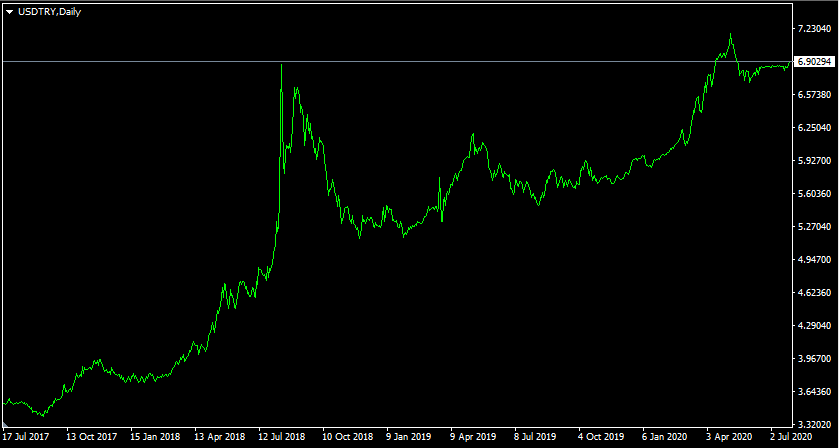
As we can see from the image above, 3 years ago the pair was trading close to 3.50 level. Yet, as we can see during the subsequent months, the US dollar has made some dramatic gains, already reaching the 6.90 level in August 2018.
However, after this development, the pair faced a sharp correction, with USD/TRY falling back to 5.20 level by February 2019. Yet, this reversal eventually turned out to be temporary. From the following month, the US dollar has resumed its upward trend. As a result of this process, the USD/TRY trade at 6.94 level by late July 2020.
So in this case, during the last 3 years, the US dollar has gained 98.3% against the Turkish lira, which is a very significant move. Now, this might be surprising for some market participants, since the bond yields on Turkish securities were consistently higher than on the US treasuries.
As the 10-year US treasury bonds fell to 0.6%, the yields on Turkish 10-year counterparts are at 12.3%. So theoretically, this should have given a tremendous advantage to Turkish lira and should have led to its significant appreciation. However, as we can see from the chart, the opposite was the case. So, how can we explain this?
Well, in order to answer this question, we need to take a look at the relative inflation rates. In June 2020, the annual inflation rate in the US stood at 0.6%, while in Turkey, this number is at 12.6%. This means that the real return on 10-year US treasuries is at 0%, while in the case of Turkey’s bonds, the real rates are at -0.3%.
So as we can see here, despite the fact that there was such a large differential between the nominal rates, the real yields on US government bonds were higher than on Turkish 10-year bonds. Also, it is worth noting that the long term average inflation is at 3% when the Turkish economy experienced double digit inflation rates for several decades.
Bond Risk Factor Affecting Forex Currency
Before moving on to the concluding remarks, it is very important to state that the real bond yields are not the only factors affecting the bond and Forex markets. Another major component, which bond traders pay a decent amount of attention to is the credit rating and solvency of the bond issuer.
The fact of the matter is that some bond investors did lose a considerable amount of money because the issuer has for whatever reason defaulted on its debt obligations. Examples of this include the default of Russia during 1998 and Argentina during 2001. Those types of events are usually very rare, however, those things do happen from time to time. Obviously, investors do not want to be caught off guard and very often analyze the solvency of the bond issuers.
Those investors in their research are assisted by credit rating agencies, the most famous of which include Moodys, S&P, and Fitch. Each of them researches the government finances of nearly all countries in the world, as well as thousands of corporations and assigns them ratings. The rating can range from AAA, which represents the outstanding investment grade to D, which is considered to be a junk bond and on the verge of or in a default
Therefore, we can conclude here that the rising bond yields do not always mean that the currency will start to appreciate against its peers. The fact of the matter is that if investors start to lose confidence in a country or company honoring its debt obligations, then some of them might start selling those bonds at a secondary market. The rest of the investors will demand higher interest rates in order to compensate for the higher risks they are taking. As a result, sometimes, faced with higher interest expense, companies and firms can no longer service their debts, and they eventually default.
Now it is worth noting that this process does not always have to end in default. During the Eurozone Sovereign Debt Crisis, the bond yields of Greece, Italy, Spain, Ireland, and Portugal have risen to unsustainable levels. As a result, the governments of those countries responded by austerity measures, dramatically reducing their spending and at the same time raising taxes.
Those unpopular measures led to mass protests and years of recessions. However, those countries did manage to regain control over their finances and eventually stabilize the situation. Yet, this process had a very negative impact on the exchange rate of their currency. In order to illustrate this, let us take a look at another weekly EUR/USD chart:
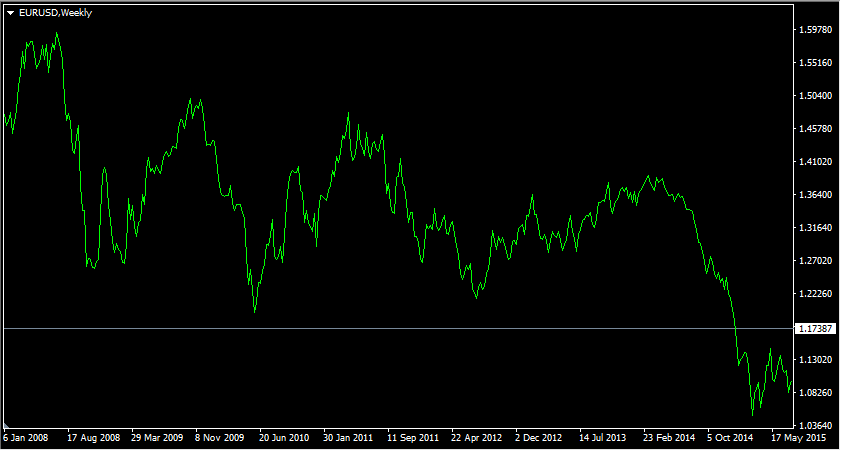
As we can see from the above diagram, after steady appreciation the Euro has reached an all-time high of $1.59 by July 2008. However, from August 2008, the single currency began its long term decline, which eventually turned out to remain in place until Spring 2015, by the time of which, the EUR/USD pair fell all the way down to $1.05.
This means that during this period, the Euro has lost approximately 1/3 of its value against the US dollar, which is a significant loss. One of the reasons for this downtrend is the Eurozone Sovereign Debt Crisis. By that time it was not clear whether some Eurozone countries would manage to avoid defaulting. Also considering the fact that the economies of those member countries are closely intertwined with each other, the default of one nation might trigger a chain reaction, leading to a number of defaults of other countries as well.
Consequently, the demand for European bonds fell significantly. We know for high insight that so far the Eurozone remained intact. However, by that time it was far from guaranteed. Therefore, it is not surprising that some investors simply did not want to take chances and withdrew money from the assets denominated in the Euro. This outflow of capital was one of the most important reasons behind the significant depreciation of the European currency.
Reasons Behind Bond Yield Changes
At this point, some people might have a very logical question: if the coupon or discount rate of the given bond is set by the government or company and remains the same throughout the term of the security, what causes the volatility of bond yields?
Well, in order to respond to this question, it is important to note that the changes in the bond yields are dependent on the movements in the prices of bond securities. For example, let us suppose that the US government issues a bond, with a nominal value of $1,000 and with the annual coupon rate of 3%. This means that the owner of this bond will receive $30 in coupon payments in a given year.
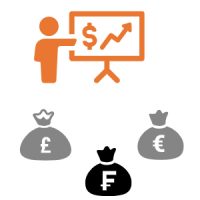
Now, what we need to remember here is that the actual market value of the bond does not necessarily have to be the same as its nominal value. If the number of buyers of bonds is higher than the sellers, then the market price of the security might rise. So if the market value of the bond rises from $1,000 to $1,050, then the bond yield will be $30 / $1,060 = 2.83%. So the yield here is lower than the interest rate of the coupon.
On the other hand, if there are more sellers in the market than buyers, then the bond prices might fall. So for example, if the price of the security falls to $920, then the yield will be $30 / $920 = 3.26%. Therefore, the yield here is notably higher than the interest rate of the coupon.
As we can see from this example, the actual market price of the security is completely negatively correlated with the bond yield. Therefore, the yield is one of the measures for the balance between supply and demand for a particular bond.
This is one of the reasons why the US government bonds have such low yields at the moment. The main reason for this is the fact that the demand for those securities is still quite high.
Basics of Bond Market Trading Forex Market Traders Should Know – Key Takeaways
- Bonds are one of the most popular types of investment vehicles, especially when it comes to risk-averse investors. Those types of securities are issued by governments and corporations in order to borrow money from investors. For shorter term bonds with one year of maturity or less are sold at a discount, so that market participants can earn some income at the end of the term. When it comes to longer term bonds, the issuer pays the interest to the lender at 6-month intervals, also known as a coupon payment.
- The latest developments in the bond market can have a notable impact on the Forex exchange rates. The higher real bond yields tend to make the currency more attractive for investors and traders. As a result, those currencies with higher bond yields tend to appreciate against other currencies. On the other hand, if the yields on bonds drop significantly, it makes the currency in question less attractive for investors and can easily lead to its depreciation against its peers.
- It is important for traders to keep in mind that the high bond yields do not always necessarily lead to the strengthening of the currency. If the rising bond yields are the result of investors losing confidence in the credit rating of the country, it can lead to the significant depreciation of the currency, in some cases even leading to the sovereign default. This scenario has already played out in 1998 in Russia and in 2001 in Argentina. In both cases, this process led to the massive depreciation of their respective currencies.



